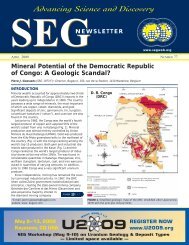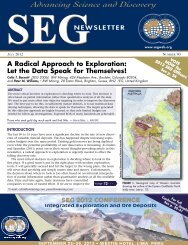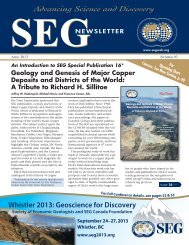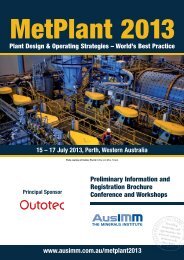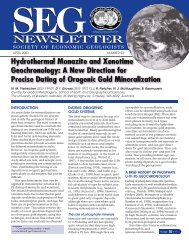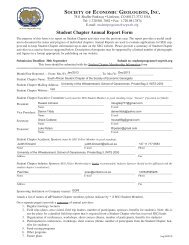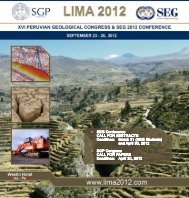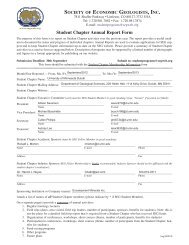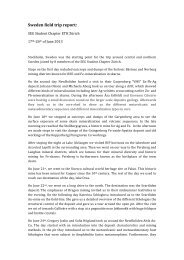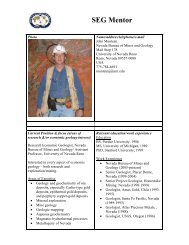SEG 45 Final_qx4 - Society of Economic Geologists
SEG 45 Final_qx4 - Society of Economic Geologists
SEG 45 Final_qx4 - Society of Economic Geologists
Create successful ePaper yourself
Turn your PDF publications into a flip-book with our unique Google optimized e-Paper software.
10 <strong>SEG</strong> NEWSLETTER No 55 • OCTOBER 2003<br />
... from 9<br />
The Golden Triangle <strong>of</strong> Southeast China: Another Carlin Trend? (Continued)<br />
little evidence <strong>of</strong> major Carboniferous<br />
or Permian compressive tectonic events.<br />
On the contrary, a Permian extensional<br />
event (or events) has been inferred from<br />
the discordance between various<br />
Permian and Triassic units, and in<br />
places disconformable contact between<br />
Middle Triassic and Late Permian sedimentary<br />
rocks (Cooke, 1998). Support<br />
for an extensional event is provided by<br />
the alkalic basalt lavas and volcaniclastic<br />
rocks <strong>of</strong> the Emeishan Basalt,<br />
deposited at the early to late Permian<br />
transition. These basalts are associated<br />
with a few ultramafic pipes.<br />
The major deformation event in<br />
the Nanpanjiang basin is the Late<br />
Cretaceous Yanshanian orogen (Li and<br />
Peters, 1998). This event produced smallscale<br />
folding and domal structures, with<br />
which gold deposits are commonly associated<br />
(Fig. 2). Apart from minor dikes,<br />
there is no associated magmatic activity<br />
(Li and Peters, 1998). Indeed, no large<br />
felsic intrusions <strong>of</strong> any age are known in<br />
western Guizhou province. This represents<br />
another major contrast with northeast<br />
Nevada where large volumes <strong>of</strong> felsic<br />
and mafic magma <strong>of</strong> various ages<br />
have been mapped.<br />
Vitrinite reflectance measurements<br />
on organic material demonstrate a<br />
regional heating event in which temperature<br />
reached between 175° and<br />
250°C (Ashley et al., 1991). The age <strong>of</strong><br />
this heating remains in doubt, although<br />
Ashley et al. (1991) suggest that it predated<br />
gold emplacement. It seems likely<br />
that this heating event was the result <strong>of</strong><br />
the Yanshanian compression.<br />
technology for treating refractory ores<br />
is rudimentary.<br />
Lannigou gold ore is found in cataclasite<br />
from near-vertical, northwest- to<br />
southeast-trending faults displacing<br />
Triassic clastic rocks, predominantly<br />
sandstone, siltstone, and argillite (Fig.<br />
3). In primary (unweathered) ore, gold<br />
is fine grained and located within arsenian<br />
pyrite and arsenopyrite. Orpiment,<br />
realgar, cinnabar, and stibnite are also<br />
conspicuous and native mercury is<br />
being recovered by local tribes-people.<br />
Pervasive hydrothermal alteration and<br />
vein phases include quartz, chalcedony,<br />
illite, ankerite and calcite (Lou, 1998).<br />
The main ore-hosting fault is interpreted<br />
as the result <strong>of</strong> compression<br />
although it has a complex history <strong>of</strong><br />
reactivation (Lou, 1998). It is related to<br />
a domal feature attributed to the<br />
Cretaceous Yanshanian orogeny. A<br />
thrust fault has been identified to the<br />
west <strong>of</strong> the deposit, and has juxtaposed<br />
limestone with the top <strong>of</strong> the mineralized<br />
clastic rocks (Fig. 3). The limestone<br />
is not known to host significant gold.<br />
The thrust fault may, however, have<br />
influenced ore deposition by creating a<br />
permeability barrier above the mineralized<br />
Triassic rocks.<br />
The Yata deposit (Fig. 2) is spatially<br />
restricted to vertical faults displacing<br />
open-folded Mid-Triassic Xinyuan<br />
Formation (Fig. 4; Ashley et al., 1991).<br />
The host rocks were originally carbonaceous<br />
ferroan-dolomite-rich shales and<br />
arkoses (Ashley et al., 1991). Of significance<br />
is the observation that ferroan<br />
dolomite and ankerite were partly<br />
removed during ore formation, supporting<br />
the idea that reactions involving the<br />
Fe in dolomite caused gold deposition<br />
(Stenger et al., 1998). Hydrothermal<br />
alteration and vein phases include<br />
quartz, illite, arsenian pyrite, and lesser<br />
arsenopyrite, stibnite, and sphalerite.<br />
Quartz ± calcite and realgar veins are<br />
Triassic<br />
Siliclastic Rocks<br />
GOLD DEPOSITS OF THE<br />
GOLDEN TRIANGLE<br />
The largest gold deposit known in the<br />
Golden Triangle is at Lannigou (Fig. 2),<br />
which was originally discovered as a<br />
mercury prospect in 1986. Caution is<br />
required in specifying a gold resource<br />
for this deposit, owing to poor core<br />
recoveries and inability <strong>of</strong> the Chinese<br />
drill rigs <strong>of</strong> the day to drill other than<br />
vertical or steeply inclined holes. It is<br />
likely, however, that the Lannigou<br />
gold resource exceeds 1 Moz. Apart<br />
from a shallow oxidized zone that<br />
extends for a few meters only, the ore<br />
is considered to be refractory. This is<br />
one reason that the Chinese government<br />
permitted foreign access, as local<br />
Gold Orebody<br />
Normal Fault<br />
Thrust Fault<br />
Fold axis<br />
0 1 km<br />
FIGURE 3. Geology <strong>of</strong> the Lannigou gold deposit, Guizhou Province. From Chinese<br />
mapping.



